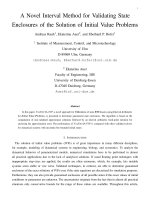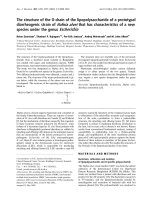Mastering metasploit 2nd
Bạn đang xem bản rút gọn của tài liệu. Xem và tải ngay bản đầy đủ của tài liệu tại đây (35.08 MB, 483 trang )
Mastering Metasploit
Table of Contents
Mastering Metasploit
Second Edition
Credits
Foreword
About the Author
About the Reviewer
www.PacktPub.com
Why subscribe?
Preface
What this book covers
What you need for this book
Who this book is for
Conventions
Reader feedback
Customer support
Errata
Piracy
Questions
1. Approaching a Penetration Test Using Metasploit
Organizing a penetration test
Preinteractions
Intelligence gathering/reconnaissance phase
Predicting the test grounds
Modeling threats
Vulnerability analysis
Exploitation and post-exploitation
Reporting
Mounting the environment
Setting up Kali Linux in virtual environment
The fundamentals of Metasploit
Conducting a penetration test with Metasploit
Recalling the basics of Metasploit
Benefits of penetration testing using Metasploit
Open source
Support for testing large networks and easy naming conventions
Smart payload generation and switching mechanism
Cleaner exits
The GUI environment
Penetration testing an unknown network
Assumptions
Gathering intelligence
Using databases in Metasploit
Modeling threats
Vulnerability analysis of VSFTPD 2.3.4 backdoor
The attack procedure
The procedure of exploiting the vulnerability
Exploitation and post exploitation
Vulnerability analysis of PHP-CGI query string parameter vulnerability
Exploitation and post exploitation
Vulnerability analysis of HFS 2.3
Exploitation and post exploitation
Maintaining access
Clearing tracks
Revising the approach
Summary
2. Reinventing Metasploit
Ruby – the heart of Metasploit
Creating your first Ruby program
Interacting with the Ruby shell
Defining methods in the shell
Variables and data types in Ruby
Working with strings
Concatenating strings
The substring function
The split function
Numbers and conversions in Ruby
Conversions in Ruby
Ranges in Ruby
Arrays in Ruby
Methods in Ruby
Decision-making operators
Loops in Ruby
Regular expressions
Wrapping up with Ruby basics
Developing custom modules
Building a module in a nutshell
The architecture of the Metasploit framework
Understanding the file structure
The libraries layout
Understanding the existing modules
The format of a Metasploit module
Disassembling existing HTTP server scanner module
Libraries and the function
Writing out a custom FTP scanner module
Libraries and the function
Using msftidy
Writing out a custom SSH authentication brute forcer
Rephrasing the equation
Writing a drive disabler post exploitation module
Writing a credential harvester post exploitation module
Breakthrough meterpreter scripting
Essentials of meterpreter scripting
Pivoting the target network
Setting up persistent access
API calls and mixins
Fabricating custom meterpreter scripts
Working with RailGun
Interactive Ruby shell basics
Understanding RailGun and its scripting
Manipulating Windows API calls
Fabricating sophisticated RailGun scripts
Summary
3. The Exploit Formulation Process
The absolute basics of exploitation
The basics
The architecture
System organization basics
Registers
Exploiting stack-based buffer overflows with Metasploit
Crashing the vulnerable application
Building the exploit base
Calculating the offset
Using the pattern_create tool
Using the pattern_offset tool
Finding the JMP ESP address
Using Immunity Debugger to find executable modules
Using msfbinscan
Stuffing the space
Relevance of NOPs
Determining bad characters
Determining space limitations
Writing the Metasploit exploit module
Exploiting SEH-based buffer overflows with Metasploit
Building the exploit base
Calculating the offset
Using pattern_create tool
Using pattern_offset tool
Finding the POP/POP/RET address
The Mona script
Using msfbinscan
Writing the Metasploit SEH exploit module
Using NASM shell for writing assembly instructions
Bypassing DEP in Metasploit modules
Using msfrop to find ROP gadgets
Using Mona to create ROP chains
Writing the Metasploit exploit module for DEP bypass
Other protection mechanisms
Summary
4. Porting Exploits
Importing a stack-based buffer overflow exploit
Gathering the essentials
Generating a Metasploit module
Exploiting the target application with Metasploit
Implementing a check method for exploits in Metasploit
Importing web-based RCE into Metasploit
Gathering the essentials
Grasping the important web functions
The essentials of the GET/POST method
Importing an HTTP exploit into Metasploit
Importing TCP server/ browser-based exploits into Metasploit
Gathering the essentials
Generating the Metasploit module
Summary
5. Testing Services with Metasploit
The fundamentals of SCADA
The fundamentals of ICS and its components
The significance of ICS-SCADA
Analyzing security in SCADA systems
Fundamentals of testing SCADA
SCADA-based exploits
Securing SCADA
Implementing secure SCADA
Restricting networks
Database exploitation
SQL server
Fingerprinting SQL server with Nmap
Scanning with Metasploit modules
Brute forcing passwords
Locating/capturing server passwords
Browsing SQL server
Post-exploiting/executing system commands
Reloading the xp_cmdshell functionality
Running SQL-based queries
Testing VOIP services
VOIP fundamentals
An introduction to PBX
Types of VOIP services
Self-hosted network
Hosted services
SIP service providers
Fingerprinting VOIP services
Scanning VOIP services
Spoofing a VOIP call
Exploiting VOIP
About the vulnerability
Exploiting the application
Summary
6. Virtual Test Grounds and Staging
Performing a penetration test with integrated Metasploit services
Interaction with the employees and end users
Gathering intelligence
Example environment under test
Vulnerability scanning with OpenVAS using Metasploit
Modeling the threat areas
Gaining access to the target
Vulnerability scanning with Nessus
Maintaining access and covering tracks
Managing a penetration test with Faraday
Generating manual reports
The format of the report
The executive summary
Methodology / network admin level report
Additional sections
Summary
7. Client-side Exploitation
Exploiting browsers for fun and profit
The browser autopwn attack
The technology behind a browser autopwn attack
Attacking browsers with Metasploit browser autopwn
Compromising the clients of a website
Injecting malicious web scripts
Hacking the users of a website
Conjunction with DNS spoofing
Tricking victims with DNS hijacking
Metasploit and Arduino - the deadly combination
File format-based exploitation
PDF-based exploits
Word-based exploits
Compromising Linux clients with Metasploit
Attacking Android with Metasploit
Summary
8. Metasploit Extended
The basics of post exploitation with Metasploit
Basic post exploitation commands
The help menu
Background command
Machine ID and UUID command
Reading from a channel
Getting the username and process information
Getting system information
Networking commands
File operation commands
Desktop commands
Screenshots and camera enumeration
Advanced post exploitation with Metasploit
Migrating to safer processes
Obtaining system privileges
Obtaining password hashes using hashdump
Changing access, modification and creation time with timestomp
Additional post exploitation modules
Gathering wireless SSIDs with Metasploit
Gathering Wi-Fi passwords with Metasploit
Getting applications list
Gathering skype passwords
Gathering USB history
Searching files with Metasploit
Wiping logs from target with clearev command
Advanced extended features of Metasploit
Privilege escalation using Metasploit
Finding passwords in clear text using mimikatz
Sniffing traffic with Metasploit
Host file injection with Metasploit
Phishing window login passwords
Summary
9. Speeding up Penetration Testing
Using pushm and popm commands
The loadpath command
Pacing up development using reload, edit and reload_all commands
Making use of resource scripts
Using AutoRunScript in Metasploit
Using multiscript module in AutoRunScript option
Globalizing variables in Metasploit
Automating Social-Engineering Toolkit
Summary
10. Visualizing with Armitage
The fundamentals of Armitage
Getting started
Touring the user interface
Managing the workspace
Scanning networks and host management
Modeling out vulnerabilities
Finding the match
Exploitation with Armitage
Post-exploitation with Armitage
Attacking on the client side with Armitage
Scripting Armitage
The fundamentals of Cortana
Controlling Metasploit
Post-exploitation with Cortana
Building a custom menu in Cortana
Working with interfaces
Summary
Further reading
Mastering Metasploit
Mastering Metasploit
Second Edition
Copyright © 2016 Packt Publishing
All rights reserved. No part of this book may be reproduced, stored in a retrieval system, or
transmitted in any form or by any means, without the prior written permission of the publisher, except
in the case of brief quotations embedded in critical articles or reviews.
Every effort has been made in the preparation of this book to ensure the accuracy of the information
presented. However, the information contained in this book is sold without warranty, either express
or implied. Neither the author, nor Packt Publishing, and its dealers and distributors will be held
liable for any damages caused or alleged to be caused directly or indirectly by this book.
Packt Publishing has endeavored to provide trademark information about all of the companies and
products mentioned in this book by the appropriate use of capitals. However, Packt Publishing cannot
guarantee the accuracy of this information.
First published: May 2014
Second edition: September 2016
Production reference: 1270916
Published by Packt Publishing Ltd.
Livery Place
35 Livery Street
Birmingham
B3 2PB, UK.
ISBN 978-1-78646-316-6
www.packtpub.com
Credits
Authors
Copy Editor
Nipun Jaswal
Safis Editing
Reviewers
Project Coordinator
Adrian Pruteanu
Kinjal Bari
Commissioning Editor
Proofreader
Kartikey Pandey
Safis Editing
Acquisition Editor
Indexer
Prachi Bisht
Pratik Shirodkar
Content Development Editor Graphics
Trusha Shriyan
Kirk D'Penha
Technical Editor
Production Coordinator
Nirant Carvalho
Shantanu N. Zagade
Foreword
With the rising age of technology, the need for IT security has not only become a necessity but a
practice that every organization must follow. Penetration testing is a practice that tends to keep
businesses and organizations safe from the external and internal threats such as information leakage,
unauthorized access to the various resources, critical business data and much more.
Companies providing services such as penetration testing and vulnerability assessments can be
thought of as a group of people paid to break into a company so that no one else can break into it.
However, the word penetration testing has a completely different meaning when it comes to law
enforcement agencies throughout the world.
A Penetration test comprises of various different phases starting with profiling of the target through
information gathering, scanning for open entrances which are also termed as port scanning, gaining
access to the systems by exploiting vulnerable entrances, maintaining access to the target and
covering tracks.
Zero day exploits and advanced persistent threats have recently dominated the cyber security scene
throughout the world by compromising small to large firms by leaking crucial business data.
Therefore, the life of a penetration tester has become quite challenging in terms of day to day
operations and it is very important for a penetration tester to keep him updated with latest tools and
techniques.
In this book, you will see penetration testing covered through a completely practical approach. The
author is a widely known security professional with his experience ranging from the top of the
corporate security structure all the way to the ground level research and exploit writing.
There are a number of books available on penetration testing, there are many covering specific
security tools in penetration testing. This book is a perfect blend of both while covering the most
widely used penetration testing framework, Metasploit, using a completely hands-on approach.
Metasploit is one of the most widely used penetration testing framework used from corporate to law
enforcement agencies. Metasploit comprises of over 1500+ modules that deliver functionalities
covering every phase of a penetration test, making the life of a penetration tester comparatively
easier. Not only it provides a comprehensive and an efficient way of conducting a penetration test but
being an open source framework, it also offers an extensive approach in developing new exploits and
automating various tasks that reduce tons of manual efforts and saves a great deal of time.
With the support of a large community, Metasploit is constantly updated with new tools and
techniques and is so frequently updated that a particular technique might change overnight. The author
undertook a massive task in writing a book on a subject, which is so frequently updated. I believe you
will find the techniques covered in this book valuable and an excellent reference in all your future
engagements.
Maj. Gen. J.P Singh, Shaurya Chakra (Retd.)
M.Sc, MBA, MMS, M.Phill
Sr. Director, Amity University
About the Author
Nipun Jaswal is an IT security business executive & a passionate IT security Researcher with more
than 7 years of professional experience and possesses knowledge in all aspects of IT security testing
and implementation with expertise in managing cross-cultural teams and planning the execution of
security needs beyond national boundaries.
He is an M.tech in Computer Sciences and a thought leader who has contributed in raising the bar of
understanding on cyber security and ethical hacking among students of many colleges and universities
in India. He is a voracious public speaker, delivers speech on Improving IT Security, Insider Threat,
Social Engineering, Wireless forensics, and Exploit writing. He is the author of numerous IT security
articles with popular security magazines like Eforensics, Hakin9, and Security Kaizen etc. Many
popular companies like Apple, Microsoft, AT&T, Offensive Security, Rapid7, Blackberry, Nokia,
Zynga.com and many others have thanked him for finding vulnerabilities in their system. He has also
been acknowledged with the Award of excellence from National cyber defense and research center
(NCDRC) for his tremendous contributions to the IT security industry.
In his current profile, he leads team super specialists in cyber security to protect various clients from
Cyber Security threats and network intrusion by providing necessary solutions and services. Please
feel free to contact him via mail at
At the very first, I would like to thank everyone who read the first edition and made it a
success. I would like to thank my mom, Mrs. Sushma Jaswal and my grandmother, Mrs.
Malkiet Parmar for helping me out at every stage of my life. I would also like to extend
gratitude to Ms. Mini Malhotra for being extremely supportive throughout the writing
process. I would like to thank Mr. Adrian Pruteanu for reviewing my work and suggesting all
the changes. I would like to thank everyone at Packt including Ms. Prachi Bisht, Ms. Trusha
Shriyan for being an excellent team and providing me with opportunity to work on this
wonderful project. Last but not the least; I would like to thank the almighty for providing me
with the immense power to work on this project.
About the Reviewer
Adrian Pruteanu is a senior consultant who specializes in penetration testing and reverse
engineering. With over 10 years of experience in the security industry, Adrian has provided services
to all major financial institutions in Canada, as well as countless other companies around the world.
You can find him on Twitter as @waydrian, or on his seldom updated blog .
www.PacktPub.com
For support files and downloads related to your book, please visit www.PacktPub.com.
Did you know that Packt offers eBook versions of every book published, with PDF and ePub files
available? You can upgrade to the eBook version at www.PacktPub.com and as a print book
customer, you are entitled to a discount on the eBook copy. Get in touch with us
at for more details.
At www.PacktPub.com, you can also read a collection of free technical articles, sign up for a range
of free newsletters and receive exclusive discounts and offers on Packt books and eBooks.
/>Get the most in-demand software skills with Mapt. Mapt gives you full access to all Packt books and
video courses, as well as industry-leading tools to help you plan your personal development and
advance your career.
Why subscribe?
Fully searchable across every book published by Packt
Copy and paste, print, and bookmark content
On demand and accessible via a web browser
"In the Memory of all our brave soldiers who lost their lives serving for the country."
Preface
Penetration testing is the one necessity required everywhere in business today. With the rise of cyberand computer-based crime in the past few years, penetration testing has become one of the core
aspects of network security and helps in keeping a business secure from internal as well as external
threats. The reason that makes penetration testing a necessity is that it helps in uncovering the
potential flaws in a network, a system, or an application. Moreover, it helps in identifying
weaknesses and threats from an attacker's perspective. Various potential flaws in a system are
exploited to find out the impact it can cause to an organization and the risk factors to the assets as
well. However, the success rate of a penetration test depends largely on the knowledge of the target
under the test. Therefore, we generally approach a penetration test using two different methods: black
box testing and white box testing. Black box testing refers to the testing where there is no prior
knowledge of the target under test. Therefore, a penetration tester kicks off testing by collecting
information about the target systematically. Whereas in the case of a white box penetration test, a
penetration tester has enough knowledge about the target under test and he starts off by identifying
known and unknown weaknesses of the target. Generally, a penetration test is divided into seven
different phases, which are mentioned as follows:
Pre-engagement interactions: This phase defines all the pre-engagement activities and scope
definitions, basically, everything you need to discuss with the client before the testing starts.
Intelligence gathering: This phase is all about collecting information about the target, which is
under the test, by connecting to the target directly and passively, without connecting to the target
at all.
Threat modeling: This phase involves matching the information detected to the assets in order to
find the areas with the highest threat level.
Vulnerability analysis: This involves finding and identifying known and unknown vulnerabilities
and validating them.
Exploitation: This phase works on taking advantage of the vulnerabilities found in the previous
phase. This typically means that we are trying to gain access to the target.
Post exploitation: The actual task to perform at the target that involves downloading a file,
shutting a system down, creating a new user account on the target, and so on, are parts of this
phase. Generally, this phase describes what you need to do after exploitation.
Reporting: This phase includes summing up the results of the test under a file and the possible
suggestions and recommendations to fix the current weaknesses in the target
The seven phases just mentioned may look easier when there is a single target under test. However,
the situation completely changes when a large network that contains hundreds of systems are to be
tested. Therefore, in a situation like this, manual work is to be replaced with an automated approach.
Consider a scenario where the number of systems under the test is exactly 100 and are running the
same operating system and services. Testing each and every system manually will consume much time
and energy. Situations like these demand the use of a penetration-testing framework. The use of a
penetration testing framework will not only save time, but will also offer much more flexibility in
terms of changing the attack vectors and covering a much wider range of targets under a test. A
penetration testing framework will eliminate additional time consumption and will also help in
automating most of the attack vectors; scanning processes; identifying vulnerabilities, and most
importantly, exploiting the vulnerabilities, thus saving time and pacing a penetration test. This is
where Metasploit kicks in.
Metasploit is considered as one of the best and most used widely used penetration testing framework.
With a lot of rep in the IT security community, Metasploit not only caters to the needs of being a great
penetration test framework but also delivers such innovative features that make life of a penetration
tester easy.
Mastering Metasploit aims at providing readers with the insights to the most popular penetrationtesting framework, that is, Metasploit. This book specifically focuses on mastering Metasploit in
terms of exploitation, writing custom exploits, porting exploits, testing services, and conducting
sophisticated client-side testing. Moreover, this book helps to convert your customized attack vectors
into Metasploit modules, covering Ruby, and attack scripting, such as CORTANA. This book will not
only caters to your penetration-testing knowledge, but will also help you build programming skills as
well.
What this book covers
Chapter 1, Approaching a Penetration Test Using Metasploit, tells you concisely about WebStorm
10 and its new features. It helps you install it, guides you through its workspace, discusses setting up
a new project, familiarizes you with the interface and useful features, and describes the ways to
customize them to suit your needs.
Chapter 2, Reinventing Metasploit, exposes the most distinctive features of WebStorm, which are at
the core of improving your efficiency in building web applications.
Chapter 3, The Exploit Formulation Process, describes the process of setting up a new project with
the help of templates by importing an existing project, serving a web application, and using File
Watchers.
Chapter 4, Porting Exploits, describes using package managers and building systems for your
application by means of WebStorm's built-in features.
Chapter 5, Testing Services with Metasploit, focuses on the state-of-the-art technologies of the web
industry and describes the process of building a typical application in them using the power of
WebStorm features.
Chapter 6, Virtual Test Grounds and Staging, shows you how to use JavaScript, HTML, and CSS to
develop a mobile application and how to set up the environment to test run this mobile application.
Chapter 7, Client-side Exploitation, shows how to perform the debugging, tracing, profiling, and
code style checking activities directly in WebStorm.
Chapter 8, Metasploit Extended, presents a couple of proven ways to easily perform application
testing in WebStorm using some of the most popular testing libraries.
Chapter 9, Speeding up Penetration Testing, is about a second portion of powerful features provided
within WebStorm. In this chapter, we focus on some of WebStorm's power features that help us boost
productivity and developer experience.
Chapter 10, Visualizing with Armitage, is about a second portion of powerful features provided
within WebStorm. In this chapter, we focus on some of WebStorm's power features that help us boost
productivity and developer experience.
What you need for this book
To follow and recreate the examples in this book, you will need six to seven systems. One can be
your penetration testing system, whereas others can be the systems under test. Alternatively, you can
work on a single system and set up a virtual environment.
Apart from systems or virtualization, you will need the latest ISO of Kali Linux, which already packs
Metasploit by default and contains all the other tools that are required for recreating the examples of
this book.
You will also need to install Ubuntu, Windows XP, Windows 7, and Windows Server 2008, Windows
Server 2012, Metasploitable 2 and Windows 10 either on virtual machines or live systems as all
these operating systems will serve as the test bed for Metasploit.
Additionally, links to all other required tools and vulnerable software are provided in the chapters.
Who this book is for
This book is a hands-on guide to penetration testing using Metasploit and covers its complete
development. It shows a number of techniques and methodologies that will help you master the
Metasploit framework and explore approaches to carrying out advanced penetration testing in highly
secured environments.
Conventions
In this book, you will find a number of text styles that distinguish between different kinds of
information. Here are some examples of these styles and an explanation of their meaning.
Code words in text, database table names, folder names, filenames, file extensions, pathnames,
dummy URLs, user input, and Twitter handles are shown as follows: " We can see that running
pattern_create.rb script from /tools/exploit/ directory, for a pattern of 1000 bytes will
generate the above output "
A block of code is set as follows:
def exploit
connect
weapon = "HEAD "
weapon << make_nops(target['Offset'])
weapon << generate_seh_record(target.ret)
weapon << make_nops(19)
weapon << payload.encoded
weapon << " HTTP/1.0\r\n\r\n"
sock.put(weapon)
handler
disconnect
end
end
When we wish to draw your attention to a particular part of a code block, the relevant lines or items
are set in bold:
weapon
weapon
weapon
weapon
<<
<<
<<
<<
make_nops(target['Offset'])
generate_seh_record(target.ret)
make_nops(19)
payload.encoded
Any command-line input or output is written as follows:
irb(main):003:1> res = a ^ b
irb(main):004:1> return res
New terms and important words are shown in bold. Words that you see on the screen, for example,
in menus or dialog boxes, appear in the text like this: "Clicking the Next button moves you to the next
screen."
Note
Warnings or important notes appear in a box like this.
Tip









